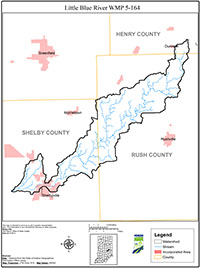Summary
The mission of the Little Blue River Watershed Project is to improve and monitor water quality in the Little Blue River Watershed.
The Little Blue River Watershed Steering Committee met during 2006 to study and identify primary water quality issues in the watershed. Based on information gathered through a Lake and River Enhancement (LARE) Diagnostic Study conducted in 2004 and other observations and data, the following issues emerged:
- E. coli levels exceed the Indiana standard at most testing sites.
- Nitrate-nitrogen concentrations regularly exceed recommended target values.
- Sedimentation is a likely contributor to poor substrate quality and embeddedness throughout streams in the watershed.
- In addition to water quality issues, the public is interested in addressing other problems such as logjams, illegal dumping, habitat/wetland degradation, and reduced recreational opportunities.
The Committee believes that water quality can be improved in the tributaries and mainstem portions of the Little Blue River by:
- Promoting public awareness and understanding of local water resources.
- Reducing nonpoint source runoff from urban sites involving construction, unprotected stream banks, fertilizer application, and impervious surfaces.
- Increasing implementation of agricultural best management practices such as conservation tillage, nutrient/pest management planning, filter strip installation, stream bank stabilization, and livestock exclusion.
- Eliminating concentrated sources of E. coli contamination from failing or poorly maintained septic systems, manure runoff, livestock access to streams, and nuisance wildlife.
- Encouraging the establishment of riparian buffers along the river’s mainstem segments and contributing tributaries.
The Committee has outlined the following goals for water quality improvement in the watershed.
- By the end of 2020, reduce E. coli bacteria levels to the state standard of 235-colonies/100 mL in the Little Blue River Watershed. Use both volunteer monitoring and lab testing to verify improvement and identify possible sources of contamination.
- By the end of 2020, reduce nitrate-nitrogen concentrations in the Little Blue River Watershed to the target value of 0.63 mg/L. Use volunteer monitoring to determine concentrations.
- Since turbidity can be an indicator of sedimentation, by the end of 2020 reduce turbidity levels in the Little Blue River Watershed to the target value of 9.89 NTU. Use volunteer monitoring and visual observation to determine NTU levels, substrate quality, and erosion issues in targeted subwatersheds.
- Cultivate citizen interest and leadership in conservation and natural resources by educating children and adults through increased hands-on learning opportunities, information brochures, workshops, and service opportunities.
These goals provide direction for specific objectives and action items identified in the Watershed Management Plan. Implementation of these ideas has already begun. The Committee has applied for a Section 319 Clean Water grant to install water quality improvement BMPs, to support educational programming, and to help realize the following vision for the watershed.

